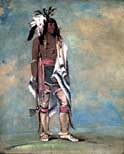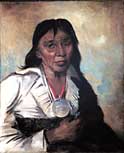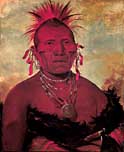
 |
| Not-o-way or The Thinker, an Iroquois chief. (watercolor by George Catlin, 1835-1836) enlarge |
The Illinois did not exist in social isolation. They interacted with a variety of other peoples, including American Indian tribes ranging east-west from the Finger Lakes region of New York (Iroquois tribes) to the central Great Plains (Pawnee tribe), and north-south from Lake Superior (Ottawa tribe) to the confluence of the Mississippi and Arkansas rivers (Quapaw tribe). Some of these interactions were peaceful, some were hostile, and others wavered back and forth. In the mid-1600s, the Illinois also began interacting with Euro-American peoples who eventually removed them from their traditional lands.![]()

![]()

![]()
Big Sail, an Ottawa chief. (watercolor by George Catlin, 1836)
enlarge
Shon-ka-ki-he-ga or Horse Chief, Pawnee chief. (watercolor by George Catlin, 1832)
enlarge
|
|
Copyright © 2000 Illinois State Museum